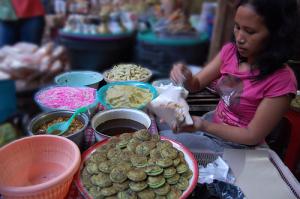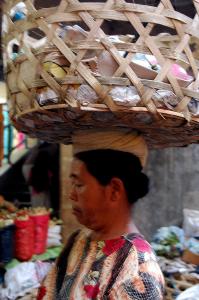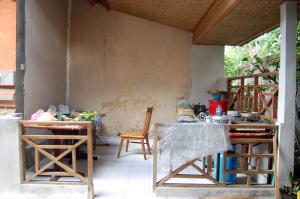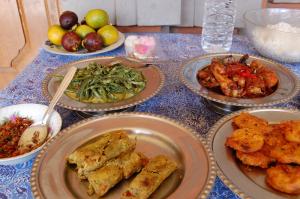
 Ubud market
Ubud market
She quickly dispelled that thought with her jolly greeting and warm smile. Then we were off to the Ubud market to purchase the ingredients for our cooking class. It was cold; I hugged my shawl tighter around me while I looked around and noticed many other women walking in the same direction, alone or in small groups of two or three. All were heading to the market, no doubt. I couldn't believe the market would be teeming with customers at this hour. It seemed as though the entire female population of Ubud were present – and then some.
I gingerly tiptoed over and around a maze of crates and mats piled high, with the radiant contrasting colors of red chilis, fiddlehead ferns, squash and shallots. All the vendors seemed to know Cok Sri. Her keen eye (and nose!) for freshness was evident as she surveyed and sniffed and then honed in for what she deemed to be just right. After procuring the vegetables we needed, she led us down the steps to the wet market for chicken and fish. While Cok Sri and Rina discussed our protein requirements, I scanned my surroundings for photo opportunities.

 Lady assembling
Lady assembling
Something caught my eye
Over by the cookies and breads, a lady was assembling what looked like multi-colored sticky cakes on a brown sheet of paper, which she drizzled with a brown syrup and then sprinkled with coconut. Afterwards she folded the paper closed and handed it to her customer before repeating the whole process. Cok Sri and Rina found me here, realizing only then that I had strayed from them. Cok Sri must have seen the drool gushing (I still hadn't had any breakfast and I was starving by then!) down to my flip-flops because she bought one each for us to have for breakfast later.

 Woman carrying our purchases
Woman carrying our purchases
With us tailing her, she continued into an alley for dried shrimp paste and peanut sauce before declaring we were done. It was only when we were back on the street did I notice we were joined by a woman carrying our purchases in a basket balanced on her head. Cok Sri dropped us at the bungalows and asked us to meet her back in her place down the road at nine o'clock. This gave us a little over an hour for a leisurely breakfast that included the bubur jajanan, a medley of glutinous rice cakes in assorted colors, shapes and textures drizzled with palm sugar syrup and shredded coconut that was acutely reminiscent of home. Kakanins, native snacks, that came to mind were cuchinta, puto and bilo-bilo. Yum!
We arrived at Cok Sri's promptly at 9:00 a.m. She lived in a traditional Balinese family complex that she shared with a slew of brothers and sisters. She called out to us from her kitchen near the rear of the complex. It was a simple galley kitchen across from another open-air kitchen area where all the ingredients were laid out. Like model pupils, Rina and I took our positions on mismatched mono bloc stools; excited and ready for our private Balinese cuisine education.
The first task was to prepare the Bali sambal: a fiery condiment of shallots, garlic, chilis and dried shrimp paste, trasi. Sambals are either raw or cooked, though in these islands it is preferred raw; untamed by cooking. It is served with everything. In this region, a meal without sambal is unthinkable. Cok Sri laid a large granite mortar on the counter in which she threw the ingredients, except the shrimp paste. She proceeded to grind everything in quick masterful strokes of the wrist.

 Open-air kitchen area
Open-air kitchen area
I liked how this mortar and pestle worked. The flat pestle with the slightly bent ergonomic handle made it easy to grind ingredients into a paste rather than pounding it. (I bought myself one). The large side of the shallow, almost flat mortar, accommodates large quantities to be ground together. It is preferable to massage the ingredients, coaxing the flavors out by hand, rather than pulverizing them with a food processor; a method used for all the dishes we learned today, except for the raw corn which was mashed in a blender.
Cok Sri fired up the stove and grabbed a pan from under the sink. She mashed the block of dried shrimp paste into it until the heat and her actions broke it down into a thick grey paste. Almost instantly, the air was filled with its pungent fishy aroma. Into it went the mashed ingredients for a quick saute, then gentle simmer. The smell it gave off was heady and almost provocative. The fumes tickled my nostrils and stirred my tummy.
Watching Cok Sri in her element was fascinating. We observed her coax the flavors from the exotic spices, expertly wrap the fish with banana leaves, effortlessly negotiate the stove top that had four pans sizzling or steaming at once, and deftly chop ingredients with quick fluid motions of her wrist. All the while she answered my questions patiently, even spelling out some names as I took down notes. She also regaled us with tales of her family without missing a beat. She had the kitchen prowess that comes only from decades of experience. She did have an assistant who helped her grate the coconut for the long beans, but she did everything else herself – no sweat. She was the picture of efficiency, constantly cleaning and packing away as she worked.

 The masterpiece
The masterpiece
Two hours later, we were ready to chow. We helped her bring out the plates to where tables had been set for us; at one of then pavilions by the courtyard. At our insistence, Cok Sri joined us for lunch and together we feasted on her masterpiece – truly works of art. I felt almost compelled to give her a standing ovation by the end of the meal. Instead, I hugged and thanked her for the wonderful meal and insightful glimpse into her culture.
Other dishes we made
Ikan Pepes– Tuna wrapped in banana leaves. The chunks of tuna were coated in a paste of turmeric, galangal, shallots, garlic, lemongrass, ginger and chili. Then they were wrapped in banana leaves with a daun salam (local bay leaf) leaf tucked in. (The daun salam tree is a member of the cassia family; its leaves impart a mild spciy/woody flavor). The wrapped fish is then steamed and afterwards grilled in a pan.
Perkedel jagung – Indonesian corn fritters. This was our favorite! They are made with shallots, nutmeg, chili and garlic; deep fried to perfection. We were eating them hot off the fryer, like popcorn.
Ayam Goreng – Spicy fried chicken. This is her children's favorite, Cok Sri tells us, and I can understand why. The chicken is fried with garlic, chili, onions and tomatoes, glazed with kecap manis. Kecap (pronounced keh-chap) is derived from the Cantonese word for sauce koe-chiap form, which the word ketchup came from). Manis is sweet soy sauce infused with palm sugar which gives its syrupy consistency. Kecap asin, on the other hand, is the regular soy sauce we are familiar with.
Long beans in coconut milk – I don't know what this is called in the local dialect, but it was delicious. I've always enjoyed local cuisine cooked with gata or coconut milk. This one was redolent with the sambal Cok Sri prepared – galangal, shallots and garlic.
Gado-gado – what would a Balinese or Indonesian cooking class be without this vegetable dish. Gado-gado loosely translates as "potpourri", and that it is – a potpourri of vegetables tossed with peanut sauce and topped with shrimp crackers. In it Cok Sri added pre-packed tahu, tofu and tempeh; a staple in these islands. Tempeh is made by fermenting half-cooked and dried soybeans with a starter yeast. It has the texture of nougat and the same nutty taste as tofu.
Cok Sri conducts cooking classes for small groups of two to four persons. If you're staying at the Puri Saraswati and are interested in attending one of her classes, the receptionist will be happy to arrange it for you. Cost is $20.00 per person, inclusive of all ingredients and a sumptuous lunch which you've learned to prepare. Now that's money well spent!